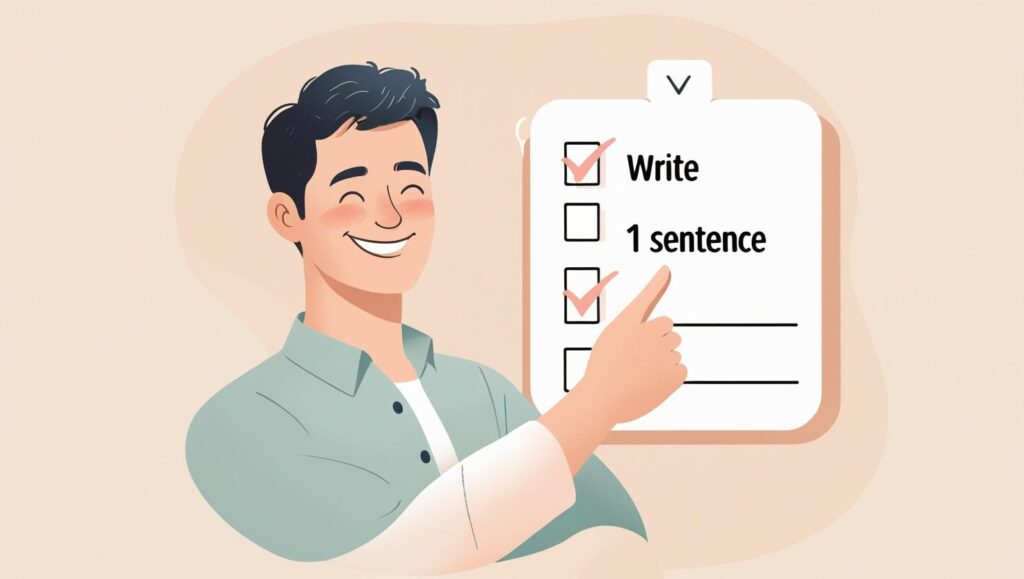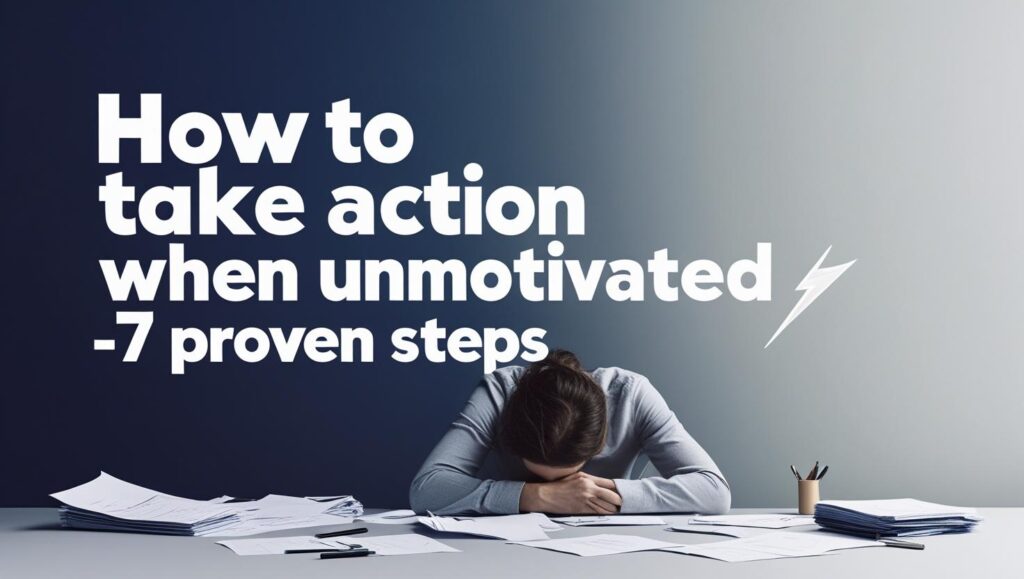Let’s be honest—motivation is unreliable. One day you’re pumped with energy, the next you’re struggling to get out of bed. But if you’re constantly waiting to feel motivated before doing anything meaningful, you’ll stay stuck longer than you think.
This is where learning how to take action when unmotivated becomes your secret weapon.
The truth is, high achievers don’t always feel motivated. They just know how to act regardless of how they feel. And so can you.
In this post, we’ll explore seven powerful strategies that help you break through inertia and make progress—even when your energy and motivation are low, and you’re unsure how to take action when unmotivated.
1. Break It Down to the Ridiculously Small

When you’re unmotivated, your brain perceives tasks as threats, making it harder to figure out how to take action when unmotivated—especially as the task grows in size and feels more overwhelming.
Solution? Shrink it down.
Instead of saying, “I need to finish this report,” tell yourself:
“I’ll just open the document and write one sentence.”
This “micro-tasking” approach tricks your brain into starting. Once you start, momentum builds naturally.
💡 Try this:
Pair micro-tasking with a timer. Set a 5-minute timer and commit to doing just that. Often, you’ll end up doing more.
Tiny actions build consistency. As we discussed in how to build momentum, starting small is often more effective than going big.
2. Shift from Outcome to Identity
Stop focusing on the end goal. Instead, shift your mindset to identity-based action:
Ask yourself, “What would a consistent person do right now?”
When you’re wondering how to take action when unmotivated, stepping into the identity of the person you want to become can remove resistance.
Examples:
- Instead of “I need to write 1,000 words,” say “I’m a writer, and writers write—even a little.”
- Instead of “I should go for a run,” say “I’m someone who takes care of their body.”
Acting from identity, not outcome, short-circuits the need for motivation.
Many people feel stuck in autopilot mode, waiting for motivation to strike. In this post on how to stop living on autopilot, we explore why awareness precedes action.
3. Use the “Action Precedes Motivation” Rule

There’s a common myth that motivation comes before action. But research shows it’s the other way around.
Action → Progress → Motivation
Even tiny actions release dopamine, the brain’s reward chemical, which is key when learning how to take action when unmotivated. Small steps create a sense of progress that sparks motivation—not the other way around.
If you’re stuck, focus on movement, not mindset.
Whether it’s cleaning your desk, replying to one email, or doing 10 jumping jacks—just move.
4. Make It Easy to Start, Hard to Quit
Environment design matters more than willpower. If your environment is working against you, no wonder you’re unmotivated.
Try these tweaks:
- Put your phone in another room when you work.
- Keep only one browser tab open.
- Lay out your gym clothes before bed.
Also, create commitment devices: tell a friend you’ll send proof of your work by 5 PM or use platforms like Stickk to create accountability contracts.
Make starting frictionless. Make quitting feel slightly uncomfortable.
5. Accept That Motivation Is Seasonal
You’re not broken if you’re not motivated all the time. You’re human.
Motivation works in waves, like energy. Instead of resisting this, work with it.
This concept is called ultradian rhythms—your body operates in 90-120 minute energy cycles. After that, productivity dips.
Structure your work in sprints:
- 50 minutes focus
- 10-minute recharge
Understanding this cycle helps you stop blaming yourself and start respecting your biology—an essential shift when learning how to take action when unmotivated.
Learn to ride your motivation waves, not fight them.
6. Emotionally Reconnect with Your “Why”

One reason people lose motivation is because they’ve lost sight of why the task matters.
Reignite your emotional connection:
- Journal: “Why does this matter to me?”
- Visualize the long-term result of consistent effort.
- Ask: “If I don’t do this, what’s at stake?”
Emotions fuel action. Logic doesn’t always move the needle—emotion does.
Even when you’re figuring out how to take action when unmotivated, tapping into your “why” can instantly lift you back into motion.
7. Set the Bar Lower… and Win Anyway
Perfectionism is one of the biggest productivity killers. If you think something has to be great to be done, you’ll stay stuck.
Instead, redefine success:
- One sentence written = success
- 10 minutes of movement = success
- One conversation started = success
Once you start stacking these micro-wins, your brain builds a track record of ‘I do what I say.’ That self-trust is key to how to take action when unmotivated.
Final Thoughts: You Don’t Need to Feel Ready. You Just Need to Begin.

Learning how to take action when unmotivated isn’t about becoming superhuman. It’s about becoming strategic.
The difference between those who move forward and those who stay stuck isn’t motivation—it’s their relationship with action.
Don’t wait to feel ready. Just move. Tiny actions, done consistently, can change everything.
You have more control than you think. And action is always available—even in your lowest moments.
